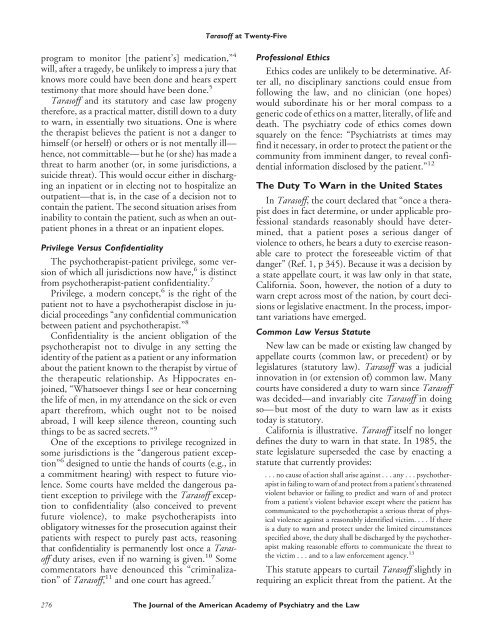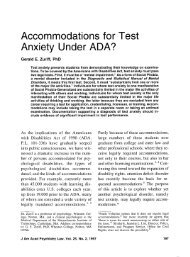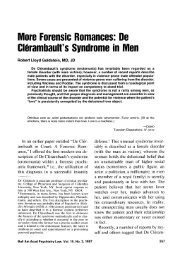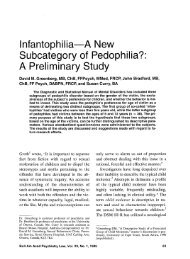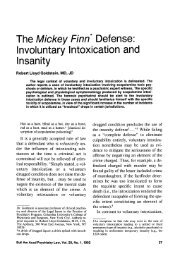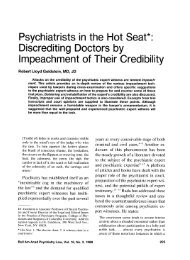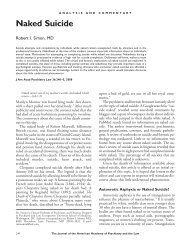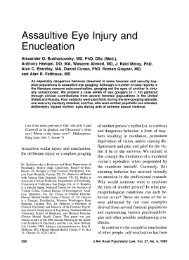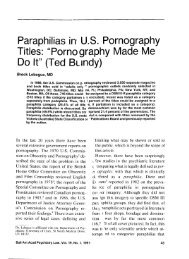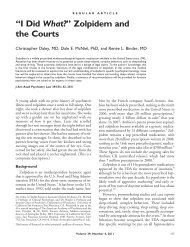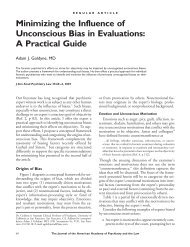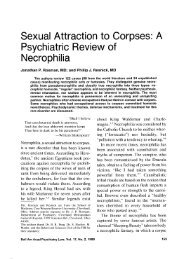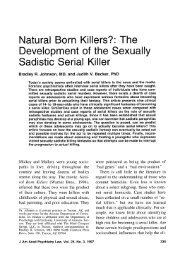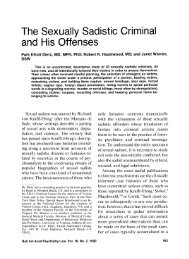Tarasoff at Twenty-Five - Journal of the American Academy of ...
Tarasoff at Twenty-Five - Journal of the American Academy of ...
Tarasoff at Twenty-Five - Journal of the American Academy of ...
You also want an ePaper? Increase the reach of your titles
YUMPU automatically turns print PDFs into web optimized ePapers that Google loves.
program to monitor [<strong>the</strong> p<strong>at</strong>ient’s] medic<strong>at</strong>ion,” 4<br />
will, after a tragedy, be unlikely to impress a jury th<strong>at</strong><br />
knows more could have been done and hears expert<br />
testimony th<strong>at</strong> more should have been done. 5<br />
<strong>Taras<strong>of</strong>f</strong> and its st<strong>at</strong>utory and case law progeny<br />
<strong>the</strong>refore, as a practical m<strong>at</strong>ter, distill down to a duty<br />
to warn, in essentially two situ<strong>at</strong>ions. One is where<br />
<strong>the</strong> <strong>the</strong>rapist believes <strong>the</strong> p<strong>at</strong>ient is not a danger to<br />
himself (or herself) or o<strong>the</strong>rs or is not mentally ill—<br />
hence, not committable—but he (or she) has made a<br />
thre<strong>at</strong> to harm ano<strong>the</strong>r (or, in some jurisdictions, a<br />
suicide thre<strong>at</strong>). This would occur ei<strong>the</strong>r in discharging<br />
an inp<strong>at</strong>ient or in electing not to hospitalize an<br />
outp<strong>at</strong>ient—th<strong>at</strong> is, in <strong>the</strong> case <strong>of</strong> a decision not to<br />
contain <strong>the</strong> p<strong>at</strong>ient. The second situ<strong>at</strong>ion arises from<br />
inability to contain <strong>the</strong> p<strong>at</strong>ient, such as when an outp<strong>at</strong>ient<br />
phones in a thre<strong>at</strong> or an inp<strong>at</strong>ient elopes.<br />
Privilege Versus Confidentiality<br />
The psycho<strong>the</strong>rapist-p<strong>at</strong>ient privilege, some version<br />
<strong>of</strong> which all jurisdictions now have, 6 is distinct<br />
from psycho<strong>the</strong>rapist-p<strong>at</strong>ient confidentiality. 7<br />
Privilege, a modern concept, 6 is <strong>the</strong> right <strong>of</strong> <strong>the</strong><br />
p<strong>at</strong>ient not to have a psycho<strong>the</strong>rapist disclose in judicial<br />
proceedings “any confidential communic<strong>at</strong>ion<br />
between p<strong>at</strong>ient and psycho<strong>the</strong>rapist.” 8<br />
Confidentiality is <strong>the</strong> ancient oblig<strong>at</strong>ion <strong>of</strong> <strong>the</strong><br />
psycho<strong>the</strong>rapist not to divulge in any setting <strong>the</strong><br />
identity <strong>of</strong> <strong>the</strong> p<strong>at</strong>ient as a p<strong>at</strong>ient or any inform<strong>at</strong>ion<br />
about <strong>the</strong> p<strong>at</strong>ient known to <strong>the</strong> <strong>the</strong>rapist by virtue <strong>of</strong><br />
<strong>the</strong> <strong>the</strong>rapeutic rel<strong>at</strong>ionship. As Hippocr<strong>at</strong>es enjoined,<br />
“Wh<strong>at</strong>soever things I see or hear concerning<br />
<strong>the</strong> life <strong>of</strong> men, in my <strong>at</strong>tendance on <strong>the</strong> sick or even<br />
apart <strong>the</strong>refrom, which ought not to be noised<br />
abroad, I will keep silence <strong>the</strong>reon, counting such<br />
things to be as sacred secrets.” 9<br />
One <strong>of</strong> <strong>the</strong> exceptions to privilege recognized in<br />
some jurisdictions is <strong>the</strong> “dangerous p<strong>at</strong>ient exception”<br />
6 designed to untie <strong>the</strong> hands <strong>of</strong> courts (e.g., in<br />
a commitment hearing) with respect to future violence.<br />
Some courts have melded <strong>the</strong> dangerous p<strong>at</strong>ient<br />
exception to privilege with <strong>the</strong> <strong>Taras<strong>of</strong>f</strong> exception<br />
to confidentiality (also conceived to prevent<br />
future violence), to make psycho<strong>the</strong>rapists into<br />
oblig<strong>at</strong>ory witnesses for <strong>the</strong> prosecution against <strong>the</strong>ir<br />
p<strong>at</strong>ients with respect to purely past acts, reasoning<br />
th<strong>at</strong> confidentiality is permanently lost once a <strong>Taras<strong>of</strong>f</strong><br />
duty arises, even if no warning is given. 10 Some<br />
comment<strong>at</strong>ors have denounced this “criminaliz<strong>at</strong>ion”<br />
<strong>of</strong> <strong>Taras<strong>of</strong>f</strong>, 11 and one court has agreed. 7<br />
<strong>Taras<strong>of</strong>f</strong> <strong>at</strong> <strong>Twenty</strong>-<strong>Five</strong><br />
Pr<strong>of</strong>essional Ethics<br />
Ethics codes are unlikely to be determin<strong>at</strong>ive. After<br />
all, no disciplinary sanctions could ensue from<br />
following <strong>the</strong> law, and no clinician (one hopes)<br />
would subordin<strong>at</strong>e his or her moral compass to a<br />
generic code <strong>of</strong> ethics on a m<strong>at</strong>ter, literally, <strong>of</strong> life and<br />
de<strong>at</strong>h. The psychi<strong>at</strong>ry code <strong>of</strong> ethics comes down<br />
squarely on <strong>the</strong> fence: “Psychi<strong>at</strong>rists <strong>at</strong> times may<br />
find it necessary, in order to protect <strong>the</strong> p<strong>at</strong>ient or <strong>the</strong><br />
community from imminent danger, to reveal confidential<br />
inform<strong>at</strong>ion disclosed by <strong>the</strong> p<strong>at</strong>ient.” 12<br />
The Duty To Warn in <strong>the</strong> United St<strong>at</strong>es<br />
In <strong>Taras<strong>of</strong>f</strong>, <strong>the</strong> court declared th<strong>at</strong> “once a <strong>the</strong>rapist<br />
does in fact determine, or under applicable pr<strong>of</strong>essional<br />
standards reasonably should have determined,<br />
th<strong>at</strong> a p<strong>at</strong>ient poses a serious danger <strong>of</strong><br />
violence to o<strong>the</strong>rs, he bears a duty to exercise reasonable<br />
care to protect <strong>the</strong> foreseeable victim <strong>of</strong> th<strong>at</strong><br />
danger” (Ref. 1, p 345). Because it was a decision by<br />
a st<strong>at</strong>e appell<strong>at</strong>e court, it was law only in th<strong>at</strong> st<strong>at</strong>e,<br />
California. Soon, however, <strong>the</strong> notion <strong>of</strong> a duty to<br />
warn crept across most <strong>of</strong> <strong>the</strong> n<strong>at</strong>ion, by court decisions<br />
or legisl<strong>at</strong>ive enactment. In <strong>the</strong> process, important<br />
vari<strong>at</strong>ions have emerged.<br />
Common Law Versus St<strong>at</strong>ute<br />
New law can be made or existing law changed by<br />
appell<strong>at</strong>e courts (common law, or precedent) or by<br />
legisl<strong>at</strong>ures (st<strong>at</strong>utory law). <strong>Taras<strong>of</strong>f</strong> was a judicial<br />
innov<strong>at</strong>ion in (or extension <strong>of</strong>) common law. Many<br />
courts have considered a duty to warn since <strong>Taras<strong>of</strong>f</strong><br />
was decided—and invariably cite <strong>Taras<strong>of</strong>f</strong> in doing<br />
so—but most <strong>of</strong> <strong>the</strong> duty to warn law as it exists<br />
today is st<strong>at</strong>utory.<br />
California is illustr<strong>at</strong>ive. <strong>Taras<strong>of</strong>f</strong> itself no longer<br />
defines <strong>the</strong> duty to warn in th<strong>at</strong> st<strong>at</strong>e. In 1985, <strong>the</strong><br />
st<strong>at</strong>e legisl<strong>at</strong>ure superseded <strong>the</strong> case by enacting a<br />
st<strong>at</strong>ute th<strong>at</strong> currently provides:<br />
. . . no cause <strong>of</strong> action shall arise against . . . any . . . psycho<strong>the</strong>rapist<br />
in failing to warn <strong>of</strong> and protect from a p<strong>at</strong>ient’s thre<strong>at</strong>ened<br />
violent behavior or failing to predict and warn <strong>of</strong> and protect<br />
from a p<strong>at</strong>ient’s violent behavior except where <strong>the</strong> p<strong>at</strong>ient has<br />
communic<strong>at</strong>ed to <strong>the</strong> psycho<strong>the</strong>rapist a serious thre<strong>at</strong> <strong>of</strong> physical<br />
violence against a reasonably identified victim. ...If<strong>the</strong>re<br />
is a duty to warn and protect under <strong>the</strong> limited circumstances<br />
specified above, <strong>the</strong> duty shall be discharged by <strong>the</strong> psycho<strong>the</strong>rapist<br />
making reasonable efforts to communic<strong>at</strong>e <strong>the</strong> thre<strong>at</strong> to<br />
<strong>the</strong> victim ...andtoalawenforcement agency. 13<br />
This st<strong>at</strong>ute appears to curtail <strong>Taras<strong>of</strong>f</strong> slightly in<br />
requiring an explicit thre<strong>at</strong> from <strong>the</strong> p<strong>at</strong>ient. At <strong>the</strong><br />
276 The <strong>Journal</strong> <strong>of</strong> <strong>the</strong> <strong>American</strong> <strong>Academy</strong> <strong>of</strong> Psychi<strong>at</strong>ry and <strong>the</strong> Law


